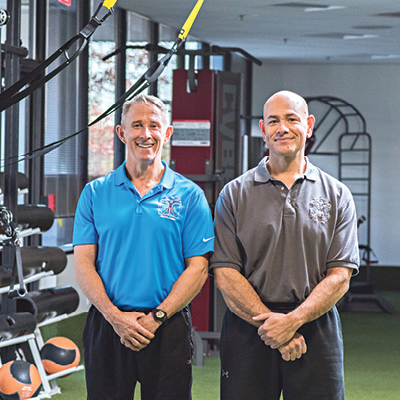Weight loss, especially fat loss, is probably the most common reason people exercise. As a result, one of the most frequent questions personal trainers get is “what is the best type of exercise to promote fat loss?” There are common misconceptions about exercise for fat loss, and there has been new thinking about this over the past decade, which we will discuss.
But before we do, imagine that I was going to begin an exercise program with the objective of losing fat, and that studies proved that disco dancing was the best exercise for fat loss. However, I do not enjoy disco dancing, but I do enjoy jogging. Would I be more likely to achieve my fat loss goal if I began a disco dancing program or if I began a jogging program? For most of us who train for overall health, fitness, performance ,and weight control, doing the absolute “best” type of exercise is less important than simply doing any form of exercise on a daily basis. Furthermore, most of us enjoy variety and have many practical considerations such as time availability, weather conditions, orthopedic or medical issues, social factors, class availability, etc., all which effect what exercise is available and practical for us each and every day.
With that said, generally speaking, exercise can contribute to fat loss in a number of ways, including:
Exercise expends energy (i.e. burns calories) and burning more calories than one consumes can contribute to fat loss.
Exercise increases the body’s metabolic rate (the amount of energy it expends) not only during the exercise bout, but for a period of time after the exercise bout is completed. This increased oxygen consumption and energy expenditure that follows an exercise bout is called EPOC (excess post-exercise oxygen consumption) and is considered valuable for weight control.
Exercise can increase the body’s production of fat burning hormones such as testosterone and growth hormone.
Exercise can help preserve or build muscle. Maintaining muscle mass is not only important to improve or maintain performance as we age, but it also helps maintain our body’s basal metabolic rate,—the amount of oxygen we consume and energy we expend throughout the day. Promoting a healthy metabolism is also considered valuable for weight control.
So let’s look at different types of exercise, or characteristics of exercise, as they relate to the above generalizations and fat loss.
For many years we have categorized exercise as aerobic (meaning with oxygen) or anaerobic (without oxygen). Aerobic exercises (also referred to as cardiovascular exercise or cardio) are exercises that can be sustained continuously without the immediate need for recovery, such as walking, jogging, dancing, distance cycling, etc. Historically, aerobic exercises have been included in athletic conditioning programs and general fitness training to help promote endurance, cardiovascular fitness, and fat loss. Anaerobic exercises are movements performed at such a high intensity that they can only be sustained for very short durations, including things like heavy weight lifting and sprinting. Anaerobic exercises have been included in both athletic conditioning programs and general fitness training to help promote increases in strength, power, and muscle mass. To this day, many fitness exercisers believe that cardio is better for weight control and weight training is good for building and toning muscle. However, there are many studies that have shown weight lifting regimens to have more of a positive impact on body composition (lowering body fat percentage) than exercise programs that are more cardio oriented. A possible reflection of this can be seen comparing the physiques of many anaerobic athletes (sprinters for example), and the physiques of aerobic athletes (like distance runners), the anaerobic athletes being much leaner. In fact, if many of the millions of gym goers who spend countless hours on cardio machines would spend more of their time lifting weights, they would probably be more likely to achieve the fat loss they seek.
Exercise can be performed at different intensity levels, for example casual walking, brisk walking, slow jogging, running and sprinting. Many previously sedentary, deconditioned people have experienced significant weight loss simply by beginning a moderate pace walking program. Moderate pace walking is a relatively low intensity, steady pace aerobic exercise. For some people, low intensity, steady pace aerobic exercise can help promote weight and fat loss. This notwithstanding, if those same people were capable of exercising safely at a higher intensity, such as fast walking, jogging, or running, for the same length of time that they walked, their exercise bouts would burn even more calories and would result in an even greater EPOC. Along these lines, high-intensity exercise could be considered better for fat loss purposes. Unless, of course, the exercise participants disliked the high intensity training so much that they did not stick with their exercise program. High-intensity training, especially resistance training with heavy workloads, also increases the body’s production of growth hormone and testosterone. Growth hormone and testosterone help build muscle and reduce body fat, additional reasons strength (anaerobic) training can be better for fat loss.
While we often label exercise as either cardio or strength, most activities and sports utilize both our aerobic and anaerobic energy systems. Many people these days participate in exercise regimens designed specifically to tax both their aerobic and anaerobic energy systems that are excellent ways to promote fat loss. While it is a misconception that cardio is better for fat loss than strength training, or high-intensity metabolic conditioning, we certainly should not ignore cardiovascular exercise because it has many proven benefits (improves heart and lung health, increases cardiovascular fitness, helps regulate blood sugar, can help prevent and even treat cancer, reduces risk of heart disease, diabetes and stroke, improves circulation, etc.) and because it can also be an excellent contributor to fat loss. High intensity training would be very difficult for most people to do every day, both psychologically and physically. There are many days that we simply may not feel up for a high-intensity workout, but we would happily go for a long walk, slow jog, or do a moderate 30 minutes of cardio on a machine while watching TV. Plus, muscles, connective tissue, and joints often need recovery between high intensity workout days. Therefore, while high intensity training may in some ways be better for fat loss, because doing something almost every day is even more valuable, lower intensity training can be considered just as good as high intensity training from an overall programmatic, activity plan standpoint.
Of course, while not the subject of this article, healthy eating and avoiding excess caloric intake (especially from refined carbohydrates), is a necessity for fat loss. Also, and again while not the subject of this article, additional ways any form of exercise can promote weight control are that exercise helps manage stress and combat depression; both which often lead to overeating. Take certain forms of yoga as an example. There are types of yoga that are relatively passive in nature (i.e. very meditative, not highly metabolically demanding—heart and respiration rates do not increase significantly, muscles are not put under great stress). Nevertheless, including this form of exercise in one’s overall activity plan can definitely contribute to weight control and weight loss.
 Clients hire personal trainers to help them get the most out of their exercise time. Clients want and expect trainers to help them not only select exercises that address their particular needs, but to help them train at an intensity level that they would be less likely to achieve without the encouragement of their trainer. Furthermore, while exercising on a daily basis is one of the most effective ways of reducing body fat and maintaining a healthy weight, many people unfortunately do not make time every day for exercise. This is all the more reason why clients want to choose the best form of exercise to achieve their goals, and why trainers most often advocate high-intensity training. At One To One we want to give our clients the greatest bang for their buck that we can. We want our clients to feel as if they not only worked smarter but also worked harder than they would without us. So our quick answer to the “what’s the best type of exercise to promote fat loss” question is high-intensity training that includes things like heavy resistance training, high-intensity anaerobic intervals, metabolics, and the like. But an even better answer, not to the exclusion of these most valuable and proven training styles, is that an activity plan that includes many different types and intensities of exercise, so that we can exercise on most days, is the best.
Clients hire personal trainers to help them get the most out of their exercise time. Clients want and expect trainers to help them not only select exercises that address their particular needs, but to help them train at an intensity level that they would be less likely to achieve without the encouragement of their trainer. Furthermore, while exercising on a daily basis is one of the most effective ways of reducing body fat and maintaining a healthy weight, many people unfortunately do not make time every day for exercise. This is all the more reason why clients want to choose the best form of exercise to achieve their goals, and why trainers most often advocate high-intensity training. At One To One we want to give our clients the greatest bang for their buck that we can. We want our clients to feel as if they not only worked smarter but also worked harder than they would without us. So our quick answer to the “what’s the best type of exercise to promote fat loss” question is high-intensity training that includes things like heavy resistance training, high-intensity anaerobic intervals, metabolics, and the like. But an even better answer, not to the exclusion of these most valuable and proven training styles, is that an activity plan that includes many different types and intensities of exercise, so that we can exercise on most days, is the best.
Please call us at 703-848-0881, or contact us on line at www.1to1fitness.com so we can help you achieve your health and fitness goals.
VivaReston Lifestyle Magazine is proud to bring our readers our new Ask a Personal Trainer column so send us your exercise and fitness questions and Doug Vasiliadis and Pat McCloskey of One To One Fitness will answer them in our upcoming issues.






